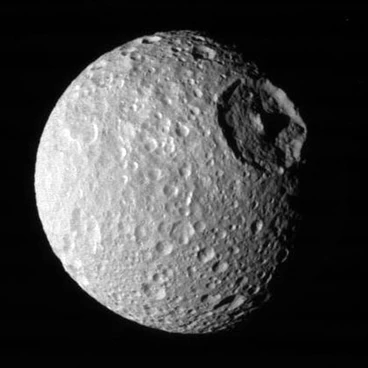
Mimas as seen by Cassini in August of 2005.
Mimas, named after one of the Gigantes in Greek mythology, is one of the closest moons to Saturn and the smallest known astronomical body that has been pulled into a rounded shape due to its own gravity. It has the second largest crater on any moon in the Solar System, named Herschel, measuring 139 kilometres across, about one-third of Mimas's mean diameter. Herschel is believed to be formed from an extremely energetic impact event. Herschel’s large size gives Mimas an uncanny resemblance to one of the Death Stars, the planet-destroying space stations used by the Galactic Empire in the Star Wars franchise.
Terraforming Mimas would be very difficult because of its proximity to Saturn, its low gravity, and its large distance from Earth. However, access to Saturn for gas mining could be made easier by establishing a base on Mimas.
Creating an atmosphere on Mimas would only last for a short period of time before it would be lost into space. Certain greenhouse gases, such as Sulfur Hexaflouride, could be introduced to warm the small moon to adequate temperatures. Since Mimas is mostly water ice with a small amount of rock, the resulting ocean would cover most of the moon, and artificial islands would need to be in place for any colonization efforts.
Mimas' largest crater, named Herschel after the moon's discoverer, would also be an ideal location for a lake or other body of water. Parts of the crater are 10km deep, and its walls are approximately 5km high. Alternately, a strong transparent dome could be placed over the crater and an atmosphere contained within, though this set up may melt ices in the crust and make the crater itself unstable
Since Mimas lacks a magnetosphere, any colonies or bases would need to be protected from Saturn's radition, though it is far weaker than Jupiter's. If possible, colonies could be built far under the frozen surface to protect those who lived there.